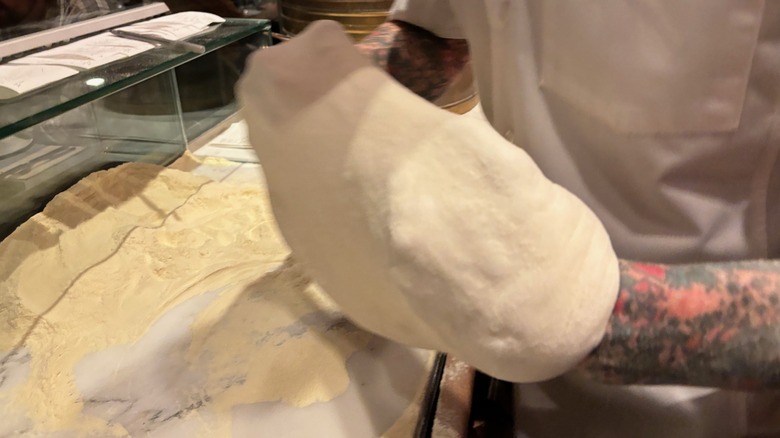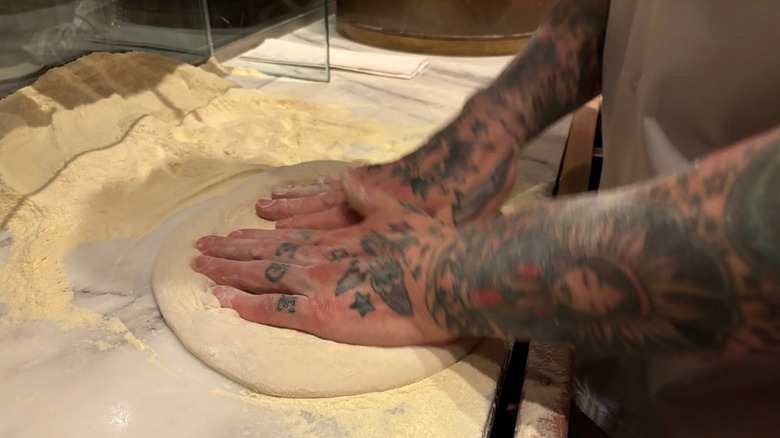For The Lightest Neapolitan Pizza Dough, Don't Toss It Around
Neapolitan pizza has several defining characteristics, and the most instantly recognizable is the signature crust. With a tall, fluffy raised rim and thin, soft center, it is a pizza style unlike any other, and this is not accidental or coincidental. The Associazione Verace Pizza Napoletana, a non-profit organization founded in Naples in 1984, has a set of International Regulations for every aspect of Neapolitan pizza, including the crust. The regulations state that the diameter should be 35 centimeters or less with a cornicione (raised border). The center of the pizza should be around ¼ centimeter in height, and the crust "should deliver the flavor of well-prepared, baked bread."
To understand what it takes to make and shape the best Neapolitan pizza, we headed to Una Pizza Napoletana in New York City to talk to pizza master Anthony Mangieri and watch him in action. His experience and deft dough handling make the art of Neapolitan pizza look easy, so we eagerly awaited his tips and techniques on what it takes to turn out a pizza with a perfectly light and crispy edge and tender middle. We learned that the dough itself and a proper rise are key, but so is the handling of the dough. There are two main ways to shape Neapolitan dough for the best pizza, and both require a combination of technique, practice, and care.
Why does a light touch matter?
Neapolitan pizza is traditionally made in the morning, left to proof all day, and then baked off at night, explains Anthony Mangieri. This long resting period creates a very airy dough that you have to handle more carefully since room-temperature dough doesn't firm up the same way refrigerated dough will. Mangieri explains that even though cold dough is easier to handle and less sticky, "it also changes the dough when it sits in the refrigerator. It's just different." So, despite the dough being more delicate at room temperature, it produces the lightest result.
For the best pizza, the dough is carefully shaped into a circle with a thicker edge and thinner center, though Mangieri acknowledged that forming a perfect round "is always tricky, even for the best pizza makers." When transferred to the hot oven, the trapped air quickly expands to create an open dough structure. Mangieri noted that starting with a dough that is "well hydrated and not over mixed should make shaping a little easier. But remember, don't overwork the dough when trying to shape it. If it's not going round, accept it and move on."
The gentle arm stretch
One way to shape the dough for Neapolitan pizza is to use your hands and arms while carefully lifting the dough. This style is traditional but takes practice to fully understand the difference between stretching and slapping the air out of the dough. The first thing to note is that this method works best with a traditional style dough made with 00 flour. Anthony Mangieri explained that the flour creates a thinner dough that cooks in about 60 to 90 seconds. "The thinner style of dough will be able to be handled rougher around the edge," he shared.
After pressing a piece of dough into a small circle, you pick up an edge, gently stretch, using your arm to guide it, and then let it fall back on the counter. When doing this motion with speed, it looks like you are slapping the dough back and forth from the hand to the counter, but it's more about using gravity to pull at the pizza dough and create a larger diameter. When handling the dough this way, avoid overstretching or knocking all the air out of the dough. Mangieri advised, "Make sure when you pick [or] pull and stretch, you are not pinching the edge of the dough." As with any shaping, he also cautioned against overworking or overdoing it.
Leave it on the counter
The second way to shape Neapolitan dough is more straightforward and how Anthony Mangieri shapes his at Una Piza Napoletana. This technique can work with any dough, but especially with a thicker, puffier style of dough made with a blend of flours. Mangieri makes shaping look easy. It only takes a few seconds for him to press a dough ball into a beautifully round pizza with air bubbles gently dotting the surface. The only time he picks it up is to carefully transfer it arm's length away to be topped. Then, he gently slides it onto a wooden pizza peel, reshapes the edges, and pops it into the wood-fired oven.
This method works best because the dough becomes more delicate to work with as it continues to proof and fill with air. Mangieri said, "By the end of the night, there is no way I could pick it up and move it around."
What happens if either of these techniques goes wrong and you end up with a mess of dough instead of a puffed beautiful round? Mangieri has you covered. "You can shape it back into a ball and let it proof again, but it's not going to be as tender as the first time you would have opened it. Or, don't reshape into a ball. Use a rolling pin to roll it out and make it a thin [or] Roman-style pizza," he suggested.



